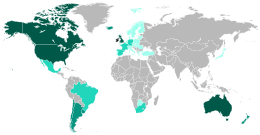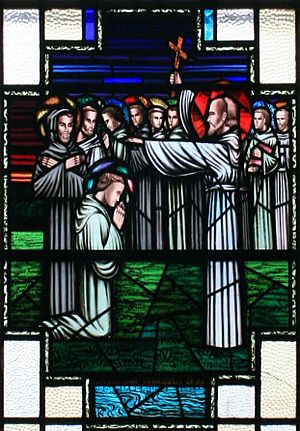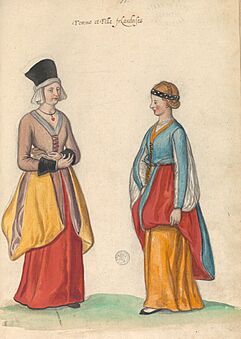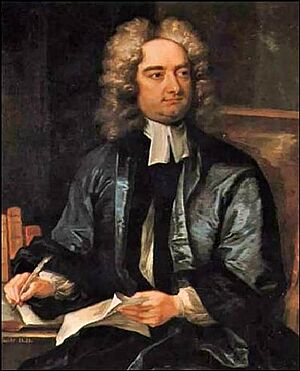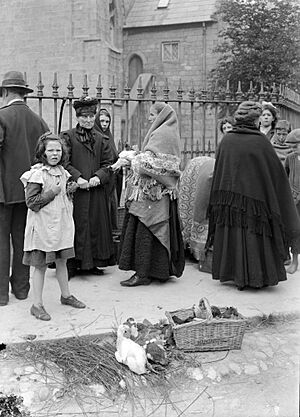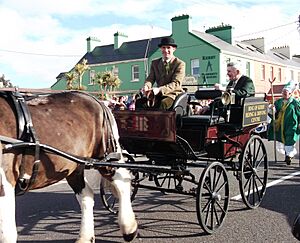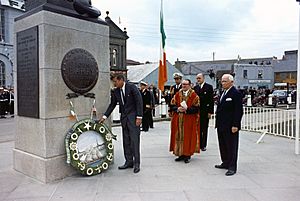Irish people facts for kids
| Muintir na hÉireann | |
|---|---|
| Total population | |
| c. 70–80 million worldwide | |
| Regions with significant populations | |
|
|
| United States | 36,000,000 |
| United Kingdom (excl. NI) | 14,000,000 (650,000 first generation) |
| Australia | 7,000,000 |
| Canada | 4,627,000 |
| New Zealand | 600,000 |
| Argentina | 500,000 |
| Chile | 120,000 |
| Brazil | 100,000 |
| Germany | 35,000 |
| France | 20,000–24,000 |
| Netherlands | 11,308 (2021) |
| Colombia | 10,000 |
| Languages | |
|
|
| Religion | |
|
|
| Related ethnic groups | |
| Irish Travellers, Gaels, Anglo-Irish, Bretons, Cornish, English, Icelanders, Manx, Scots, Ulster Scots, Welsh | |
The Irish people (Irish: Muintir na hÉireann or Na hÉireannaigh) are an ethnic group and nation who originally come from the island of Ireland. They share a common background, history, and culture. People have lived in Ireland for over 10,000 years. For most of its recorded history, the Irish were mainly a Gaelic people.
Over time, other groups settled in Ireland. Vikings arrived from the 9th century, and Anglo-Normans came in the 12th century. In the 16th and 17th centuries, many English and Lowland Scots moved to parts of Ireland, especially the north. Today, Ireland is divided into the Republic of Ireland and Northern Ireland, which is part of the United Kingdom. People in Northern Ireland can identify as British, Irish, or Northern Irish.
The Irish have their own special customs, including the Irish language, music, dance, sports, food, and myths. While Irish (Gaeilge) was once their main language, most Irish people today speak English. In the past, Irish society was based on family groups called clans. They also had their own religion, laws, alphabet, and clothing styles.
Many famous Irish people have made their mark on history. After Ireland became Christian, Irish missionaries and scholars had a big impact on Europe. They were known as a nation of "saints and scholars." Important figures include Columbanus, a 6th-century monk, and scientists like Robert Boyle, known as the "father of chemistry." Irish literature has produced world-famous writers such as Jonathan Swift, Oscar Wilde, W. B. Yeats, and James Joyce. Brave Irish explorers like Sir Ernest Shackleton also made history. Many U.S. presidents have Irish roots.
About 6.9 million people live in Ireland today. However, it's thought that 50 to 80 million people around the world have Irish ancestors. This makes the Irish diaspora (people of Irish descent living outside Ireland) one of the largest in the world. Historically, people left Ireland due to conflicts, famines, and economic problems. Most people of Irish descent live in English-speaking countries like Great Britain, the United States, Canada, New Zealand, and Australia. There are also many in Argentina, Germany, and The United Arab Emirates. The United States has the most people of Irish descent, while Australia has the highest percentage of its population with Irish roots outside of Ireland.
Contents
Who Are the Irish People?
Ancient Roots and Legends

Over the last 33,000 years, different groups of people have arrived in Ireland. The name Irish and Ireland likely come from the goddess Ériu. Many ancient tribes lived on the island, like the Fir Bolg and Érainn. Some legends say the Irish are descended from the Milesians, who supposedly conquered Ireland long ago.
Irish Travellers: A Distinct Group
Irish Travellers are an ethnic group from Ireland. Studies show they originally came from the wider Irish population but became a separate group a long time ago. Their distinct culture may have started around 1597, when many native Irish people were forced off their land. This might have led to some becoming a nomadic (traveling) population.
A Look at Irish History
Early Christianity and Influence
Ancient Irish history includes famous figures like the High Kings of Ireland and the legendary Fianna warriors. When Christianity arrived in the 5th century, it greatly changed Ireland's connections with other countries. Irish missionaries and scholars traveled across Europe, sharing their knowledge and faith.
The 6th-century Irish monk Columbanus is even called "one of the fathers of Europe." Other Irish saints, like Aidan of Lindisfarne, Kilian, and Vergilius, became important figures in other countries. Irish scholars were known for their learning in the Frankish court of Charlemagne. They even knew Greek, which was rare in Western Europe at the time.
Vikings and Normans Arrive

In the 9th and 10th centuries, Viking raiders and traders came to Ireland. They founded many important towns like Cork, Dublin, Limerick, and Waterford. The Vikings had little other lasting impact on Ireland, but some Irish people taken as slaves married Scandinavians, creating links with the Icelandic people.
Later, the Anglo-Normans arrived, bringing people from Wales, Flanders, and other places. Most of these newcomers eventually blended into Irish culture by the 15th century.
Irish Surnames: A Family Story
The Irish were among the first people in Europe to use surnames as we do today. Many Irish surnames start with 'Ó' or 'Mac'. 'Ó' comes from the Irish Ua, meaning "grandson" or "descendant" of a named person. 'Mac' means "son" in Irish.
- Surnames with "O'": O'Brien, O'Kelly, O'Connell, O'Neill, O'Sullivan.
- Surnames with "Mac" or "Mc": McCarthy, McDermott, McDonnell, McMahon, Maguire.
The proper surname for a woman in Irish uses 'Nic' (meaning daughter) instead of 'Mac', or 'Ní' instead of 'Ó'. For example, a boy might be Mac Domhnaill, but his sister would be Nic Dhomhnaill.
Some Irish surnames come from Norse (Viking) names, like Sweeney (from Swein) and McAuliffe (from Olaf). The name "Fitz" in surnames like FitzGerald means "son of" in old Norman French. These names usually show descent from the early Norman settlers in Ireland. Other common Irish surnames, like "Walsh," were given to settlers who came from Wales.
Life in Medieval Ireland
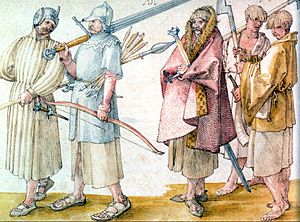
In the Late Middle Ages, Irish people were active traders in Europe. They used Latin when traveling abroad, which was spoken by educated people across Ireland.
In 1515, an English report said that the Irish people were divided into over sixty Gaelic lordships (areas ruled by a lord). The Irish word for these areas was "oireacht." This also referred to the people living there. The Irish had their own legal system, and people loved "equal and impartial justice."
Family history and genealogy were very important in Irish society. Different types of learning, like law, poetry, history, and medicine, were often passed down through specific families.
Plantations: New Settlers Arrive
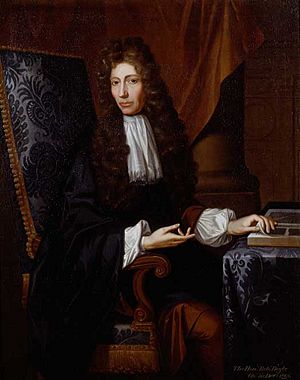
In the 16th century, the English began to colonize parts of Ireland. This was called the "Plantations of Ireland." The first plantations started in the 1550s.
Later, in the 17th century, the Plantation of Ulster brought many Scottish and English settlers to the north of Ireland. This was the most successful plantation. After the Irish rebels were defeated, more English settlers, known as the Protestant ascendancy, also came to Ireland.
Great Minds and Writers
Ireland has produced many important scientists. Robert Boyle (1627–1691), an Anglo-Irish scientist, is known as the "father of chemistry." Francis Beaufort (1774–1857) created the Beaufort scale for measuring wind force. George Boole (1815–1864) invented Boolean algebra, which is important in computer science.
The traditional Irish system of poets and scholars declined after the plantations. However, Irish poets continued to write. Despite strict laws, Irish Catholics still received education in secret "hedgeschools."
For a small country, Ireland has made a huge contribution to literature. Famous Irish writers, playwrights, and poets include Jonathan Swift, Oscar Wilde, James Joyce, George Bernard Shaw, and W.B. Yeats.
The Great Famine and Its Impact
An Górta Mór: The Great Hunger

The Great Irish Famine, known as An Górta Mór ("The Great Hurt") in Irish, happened from 1845 to 1849. It was a terrible time when millions of Irish people died or left the country. The worst year was 1847, called "Black '47." The famine happened because the potato crop, which was the main food for many poor Irish people, was destroyed by a disease called Blight. At the same time, other crops and livestock were taken by the British government.
People who tried to eat the diseased potatoes became sick. Soup kitchens were set up, but they didn't help enough. The British government sent little aid. Many workhouses, meant to help the starving, were full of diseases like cholera, and many people died there. Some British politicians at the time even saw the famine as a way to reduce the native Irish population.
Leaving Ireland: Coffin Ships
To escape the famine, many Irish people emigrated, mostly to the east coast of the United States, especially Boston and New York. They also went to Liverpool in England, Australia, Canada, and New Zealand. Many who went to Australia were prisoners, some of whom committed crimes just to be sent there instead of facing hardship at home.
Emigrants traveled on "Coffin Ships," named for the high death rates on board. Many died from disease or starvation. Conditions were terrible, and passengers were often treated like cargo. Famous coffin ships include the Jeanie Johnston and the Dunbrody.
Today, there are statues and memorials in Dublin, New York, and other cities to remember the famine. The song "The Fields of Athenry" is about the famine and is often sung at Irish sporting events. The Great Famine is a huge part of Irish history and identity. It fueled Irish nationalism and the fight for independence from British rule.
Modern Irish Identity
Ireland Divided: Republic and Northern Ireland
After the Irish War of Independence (1919–1921), the Anglo-Irish Treaty was signed. This created the independent Irish Free State (now the Republic of Ireland), which included 26 of Ireland's 32 counties. The other six counties in the northeast remained part of the United Kingdom as Northern Ireland.
The main differences between the two parts are religion, history, and politics. In Northern Ireland, people identify in different ways. Surveys show that most Protestants identify as "British" or "Ulster," while most Catholics identify as "Irish."
Religion in Ireland Today

In the Republic of Ireland, about 69.1% of the population is Catholic (2022). In Northern Ireland, about 41.6% are Protestant, and 40.8% are Catholic (2011). While most Irish people in the Republic still identify as Catholic, fewer people attend church regularly now. Church attendance has also declined in Northern Ireland.
What Defines Being Irish?
Thomas Davis, an important Irish nationalist, believed the Irish were a Celtic nation. He thought most Irish people were of Gaelic Irish origin or descended from Scottish Gaels and Welsh Celts. He strongly supported the Irish language as the "national language." He also believed that people of Germanic origin (like Normans and Anglo-Saxons) could become Irish if they wanted to be part of the Irish Nation.
Ireland's relationship with Europe and America is also discussed. As Mary Harney, a former Irish leader, said in 2000, "Geographically we are closer to Berlin than Boston. Spiritually we are probably a lot closer to Boston than Berlin." This shows the strong ties Ireland has with both continents.
The Irish Diaspora: Irish People Around the World
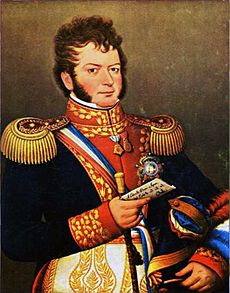
The Irish diaspora includes Irish emigrants and their descendants living in other countries. These include the United States, Great Britain, Canada, Australia, New Zealand, and some Caribbean nations like Jamaica and Barbados. These countries have many people of Irish descent.
Many famous and influential people have Irish ancestry, such as Che Guevara, Walt Disney, Barack Obama, JFK, and Muhammad Ali.
Many Irish people were also sent to the island of Montserrat as indentured servants or exiled prisoners. Unlike African slaves, most Irish laborers went to Montserrat by choice. Some were Irish soldiers exiled by Oliver Cromwell. On March 17, 1768, African slaves on the island tried to rebel against Irish plantation owners, choosing St. Patrick's Day because they thought the owners would be distracted. The plot was discovered, and many involved were executed. Today, Montserrat celebrates St. Patrick's Day as a public holiday to remember this revolt.
People of Irish descent are also strong in Latin America, especially in Argentina, and in Brazil, Chile, and Mexico. In 1995, Irish President Mary Robinson reached out to the "70 million people worldwide who can claim Irish descent." Today, the diaspora is believed to be around 80 million people.
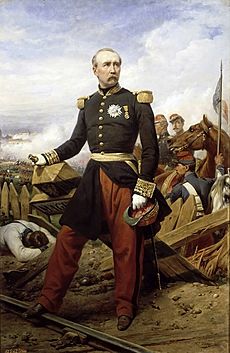

There are also large Irish communities in European countries like Spain, France, and Germany. Between 1585 and 1818, over half a million Irish people left Ireland to serve in wars on the European continent. This constant emigration was called the "Flight of the Wild Geese." Irish soldiers were known for their bravery. The 1st Duke of Wellington, an Irish-born military leader, said that "Ireland was an inexhaustible nursery for the finest soldiers."
The British Legions were units that fought with Simón Bolívar for the independence of countries like Colombia and Venezuela. These units included over seven thousand volunteers, many of whom were Irish. The most famous reason for Irish emigration was the Great Famine in the 1840s. A million people are thought to have moved to Liverpool alone because of it. The famine became a powerful memory for Irish people everywhere, fueling nationalist movements.
There are also Afro-Caribbean people descended from Irish immigrants in the Caribbean, especially on Barbados, Jamaica, and Montserrat. They often have Irish surnames and speak a form of Caribbean English influenced by Irish.
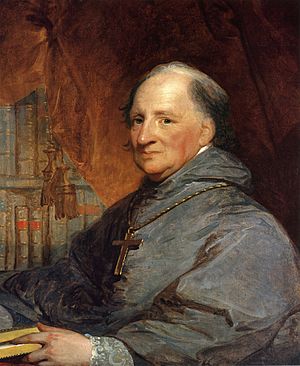

People of Irish descent are the second largest self-reported ethnic group in the United States. Nine people who signed the American Declaration of Independence had Irish origins. At least twenty-five U.S. presidents have some Irish ancestry, including George Washington. Since John F. Kennedy became president in 1961, every American President (except Gerald Ford and Donald Trump) has had some Irish blood. An Irish-American, James Hoban, designed the White House. Commodore John Barry, born in County Wexford, is known as the "Father of the United States Navy."
In the mid-19th century, many Irish immigrants joined the United States Army during the Mexican–American War. Some deserted to the Mexican Army to escape bad treatment and anti-Catholic discrimination. These were the San Patricios, or Saint Patrick's Battalion, a group of Irish soldiers led by John O'Riley. They are remembered in Mexico every year on September 12.
Between the 18th and 19th centuries, about 300,000 free emigrants and 45,000 convicts left Ireland for Australia. Today, Australians of Irish descent are one of the largest ethnic groups in Australia. The Australian embassy in Dublin says that up to 30% of Australians claim some Irish ancestry.
Around 30,000 Irish people moved to Argentina between the 1830s and 1890s. This was encouraged by the clergy, who preferred a Catholic country like Argentina over the more Protestant United States. However, there was little planning for their arrival, leading to hardship for many. Some famous Argentines with Irish roots include Che Guevara and former president Edelmiro Julián Farrell.
People of Irish descent are found all over South America, like the Chilean liberator Bernardo O'Higgins. Some Irish surnames changed to fit the Spanish language, for example, O'Brien became Obregón.
In Canada, people of Irish descent are one of the largest ethnic groups, numbering around 4,354,155 in 2006.
See also
 In Spanish: Pueblo irlandés para niños
In Spanish: Pueblo irlandés para niños


